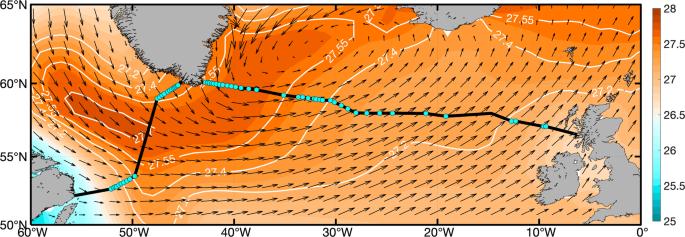Seasonality of the Meridional Overturning Circulation in the subpolar North Atlantic
IF 8.1
1区 地球科学
Q1 ENVIRONMENTAL SCIENCES
引用次数: 7
Abstract
Understanding the variability of the Atlantic Meridional Overturning Circulation is essential for better predictions of our changing climate. Here we present an updated time series (August 2014 to June 2020) from the Overturning in the Subpolar North Atlantic Program. The 6-year time series allows us to observe the seasonality of the subpolar overturning and meridional heat and freshwater transports. The overturning peaks in late spring and reaches a minimum in early winter, with a peak-to-trough range of 9.0 Sv. The overturning seasonal timing can be explained by winter transformation and the export of dense water, modulated by a seasonally varying Ekman transport. Furthermore, over 55% of the total meridional freshwater transport variability can be explained by its seasonality, largely owing to overturning dynamics. Our results provide the first observational analysis of seasonality in the subpolar North Atlantic overturning and highlight its important contribution to the total overturning variability observed to date. Subpolar overturning in the North Atlantic Ocean shows substantial seasonality, with a maximum in late spring, a minimum in early winter, and a total range of about 9 Sv, according to observations from the OSNAP array between 2014 and 2020.

北大西洋副极地经向翻转环流的季节性。
了解大西洋经向翻转环流的可变性对于更好地预测我们不断变化的气候至关重要。在这里,我们展示了一个更新的时间序列(2014年8月至2020年6月),来自亚极地北大西洋计划的倾覆。6年时间序列使我们能够观察副极地翻转、经向热量和淡水输送的季节性。倾覆在春末达到峰值,在初冬达到最小值,峰谷范围为9.0 Sv.倾覆的季节性时间可以用冬季转变和密集水的输出来解释,这是由季节性变化的埃克曼运输所调节的。此外,超过55%的总经向淡水输送变化可以用其季节性来解释,这主要是由于倾覆动力学。我们的结果首次对副极地北大西洋倾覆的季节性进行了观测分析,并强调了其对迄今为止观测到的总倾覆变化的重要贡献。
本文章由计算机程序翻译,如有差异,请以英文原文为准。
求助全文
约1分钟内获得全文
求助全文
来源期刊

Communications Earth & Environment
Earth and Planetary Sciences-General Earth and Planetary Sciences
CiteScore
8.60
自引率
2.50%
发文量
269
审稿时长
26 weeks
期刊介绍:
Communications Earth & Environment is an open access journal from Nature Portfolio publishing high-quality research, reviews and commentary in all areas of the Earth, environmental and planetary sciences. Research papers published by the journal represent significant advances that bring new insight to a specialized area in Earth science, planetary science or environmental science.
Communications Earth & Environment has a 2-year impact factor of 7.9 (2022 Journal Citation Reports®). Articles published in the journal in 2022 were downloaded 1,412,858 times. Median time from submission to the first editorial decision is 8 days.
 求助内容:
求助内容: 应助结果提醒方式:
应助结果提醒方式:


